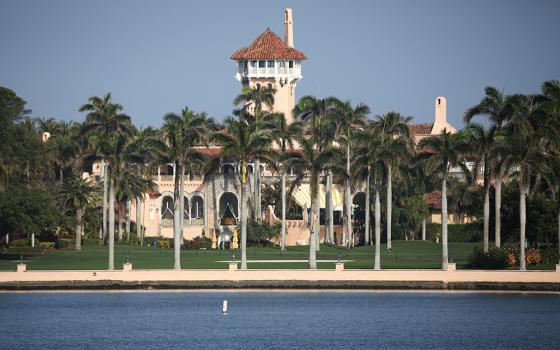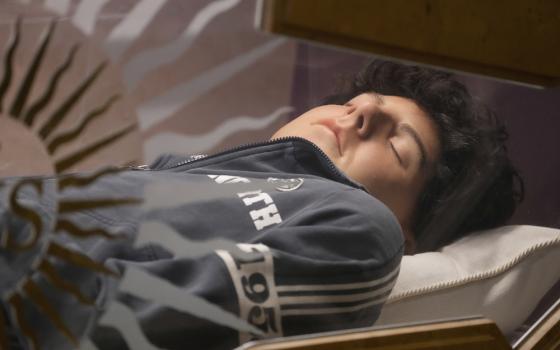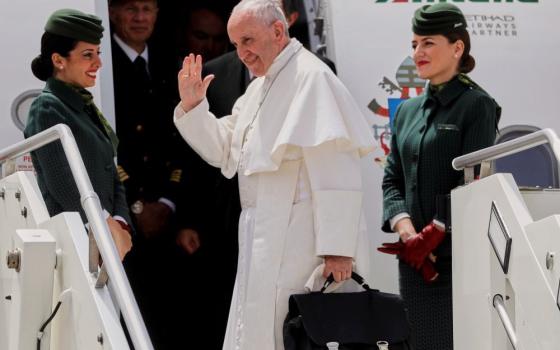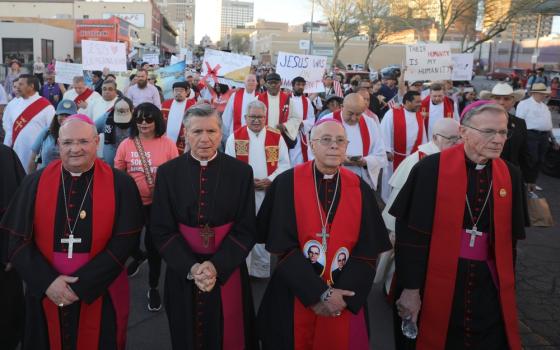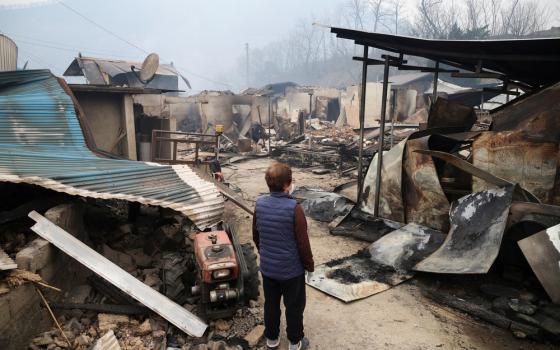Archbishop Michael Miller of Vancouver, British Columbia, Tk'emlúps te Secwépemc First Nation media relations coordinator Racelle Kooy (top right), and Tk'emlúps te Secwépemc First Nation Chief Rosanne Casimir during a press conference June 26, 2024, answer questions about the "Sacred Covenant" signed Easter Sunday. (OSV News screenshot/Courtesy of B.C. Catholic)
Officials of the Archdiocese of Vancouver, British Columbia, and a First Nation where the largest Indigenous residential school in Canada was located reiterated their joint commitment June 26 to press forward with learning more about the mistreatment of thousands of Indigenous children by a government education program administered by some Catholic religious orders at such schools that ran for nearly 100 years.
The archdiocese and Tk'emlúps te Secwépemc First Nation marked Canada's Indigenous Peoples Day June 21 by releasing to the public a signed "Sacred Covenant," written in both English and Chinook.
The document states the Catholic Church recognizes the "profoundly negative" impact and "lasting and damaging effect" of the inadequately funded government program that forced First Nations children to be separated from their families, disallowed the use of their own languages and cultural heritage, and subjected them to various types of abuse and neglect.
"The church was wrong, wrong, in how it complied in implementing a government colonist policy which resulted in the separation of children from their parents and their families," said Vancouver Archbishop Michael Miller, whose archdiocese is in Western Canada where most of the residential schools were located.
"Even the most ardent skeptics must know that a system requiring or pressuring the separation of families would have devastating consequences, tragic consequences," he said June 26 at an online media briefing about the covenant.
Advertisement
The document signed March 31 by Miller, Bishop Joseph Nguyen of Kamloops, British Columbia, and Tk'emlúps te Secwépemc Chief Rosanne Casimir details a timeline that begins with a papal bull of the 1500s where the church committed to respecting Indigenous peoples' rights to their liberty and possessions while carrying out efforts to bring them to the faith. Furthermore, it notes Pope Paul V agreed to an oral concordat (recorded in a wampum belt) with the Mi'kmaq nation, recognizing their "rights, jurisdiction, and traditions within their territory," their sovereignty and the church's right "to spread Catholicism within Mi'kmaq territory."
It includes the tumultuous years that followed the creation of residential schools in the late 1800s, including the 1920 Indian Act that required all Indigenous children to attend day school or residential schools.
The signed document highlights the settlement agreement of 2007 and the resulting 2008 public apologies by Canada's prime minister for the government schools and the church for its treatment of Indigenous students at those schools. The agreement called for a Truth and Reconciliation Commission to investigate the impact of residential schools and create historical records of findings. It also mandated cash and remuneration be paid in full, which the document noted "while technically completed, fell far short of the stated objectives."
Over an eight-year period the commission spoke with 6,500 witnesses about the residential school system and its impact. It found more than 3,200 children were reported to have died at the residential schools in their 150 year history. The commission said many died "far from home" and that it was unclear where the children were buried.
The commission found communicable diseases to be the primary cause of poor health and death among Indigenous people and the document says researchers believe the children may have been sick before being housed at the poorly run schools or that they contracted illness because of overcrowding and unsanitary conditions at the schools.
In 2021, a ground-penetrating radar survey on land of the Kamloops Indian Residential School found more than 200 "anomalies," which are suspected burial sites.
A year later, Pope Francis went to Canada and apologized for members of the church who participated "in projects of cultural destruction and forced assimilation" calling the government policies on the schools "catastrophic" and "incompatible with the Gospel of Jesus Christ."
Casimir said at the briefing that the section on "commitments to action" in the "Sacred Covenant" will be the path forward for all the signatories. She noted some action items.
"We are going to seek fitting ways to memorialize the children at residential schools and regularly call them to mind in sacred ceremonies that we shall conduct together to ensure that their lives are never forgotten," she said. "We will work together and share information in full transparency to determine the truth: the identities of the children, the circumstances of their deaths, and all the information about the missing children to ensure that we can accurately determine their home communities, so they can rest in peace and their families can have answers that they so seek."
Casimir said forming the covenant has set "a lot of precedents" in Canada and that it has meant building partnerships in order to take steps toward healing and justice.
"It takes everybody at every level to be walking that path and journeying together and so I would encourage others to also establish those relationships to be able to take those meaningful steps," she said.
In a May 27 reflection addressed to "the Tk'emlúps te Secwépemc, community and allies" on the third anniversary of the finding of the 200 suspected burial sites, Casimir said, "At this time we are deep into the investigative work" and that so far the findings are consistent with burial sites.
In the "Sacred Covenant," the church pledges to provide scientific and technical expertise and technical services for the investigation. Miller confirmed funds for this and what "the First Nations request to be done to further healing and reconciliation" will come from $22 million in grants announced by the Canadian bishops in 2021.
He thanked Casimir for the First Nation's collaboration with the church in their efforts toward reconciliation and healing.
Miller said, "Beyond the learning we have received it has been the kindness and the openness of the people that has moved me most deeply and been a cause of great hope."
